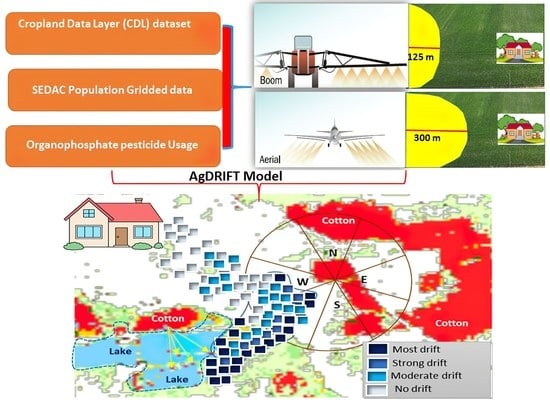Effectiveness of Utilizing Remote Sensing and GIS Techniques to Estimate the Exposure to Organophosphate Pesticides Drift over Macon, Alabama
Abstract
1. Introduction
2. Materials and Methods
2.1. Study Area
2.2. The Data
2.2.1. Cropland and LULC Data
2.2.2. Pesticide Usage Data
2.2.3. Gridded Population Data
2.2.4. Meteorological Data
2.3. The Methodology
2.4. Assumptions and Limitations of the Study
3. Results and Discussion
3.1. Potential Pesticide Drift Estimation on the County Level
3.2. Potential Pesticide Drift Estimation on Field Level
4. Conclusions
Author Contributions
Funding
Data Availability Statement
Acknowledgments
Conflicts of Interest
References
- Benbrook, C.M. How Did the US EPA and IARC Reach Diametrically Opposed Conclusions on the Genotoxicity of Glyphosate-Based Herbicides? Environ. Sci. Eur. 2019, 31, 2. [Google Scholar] [CrossRef]
- Burchfield, S.L.; Bailey, D.C.; Todt, C.E.; Denney, R.D.; Negga, R.; Fitsanakis, V.A. Acute Exposure to a Glyphosate-Containing Herbicide Formulation Inhibits Complex II and Increases Hydrogen Peroxide in the Model Organism Caenorhabditis Elegans. Environ. Toxicol. Pharm. 2019, 66, 36–42. [Google Scholar] [CrossRef]
- Centner, T.J.; Russell, L.; Mays, M. Viewing Evidence of Harm Accompanying Uses of Glyphosate-Based Herbicides under US Legal Requirements. Sci. Total Environ. 2019, 648, 609–617. [Google Scholar] [CrossRef] [PubMed]
- Worldatlas. 2022. Available online: https://www.worldatlas.com/articles/toppesticide-consuming-countries-of-the-world.html (accessed on 21 April 2023).
- Sharma, A.; Kumar, V.; Shahzad, B.; Tanveer, M.; Sidhu, G.P.S.; Handa, N.; Kohli, S.K.; Yadav, P.; Bali, A.S.; Parihar, R.D.; et al. Worldwide Pesticide Usage and Its Impacts on Ecosystem. SN Appl. Sci. 2019, 1, 1446. [Google Scholar] [CrossRef]
- Wang, M.; Rautmann, D. A Simple Probabilistic Estimation of Spray Drift—Factors Determining Spray Drift and Development of a Model. Environ. Toxicol. Chem. 2008, 27, 2617–2626. [Google Scholar] [CrossRef]
- Boffetta, P.; Adami, H.-O.; Berry, S.C.; Mandel, J.S. Atrazine and Cancer: A Review of the Epidemiologic Evidence. Eur. J. Cancer Prev. 2013, 22, 169–180. [Google Scholar] [CrossRef]
- Chen, M.; Chang, C.-H.; Tao, L.; Lu, C. Residential Exposure to Pesticide During Childhood and Childhood Cancers: A Meta-Analysis. Pediatrics 2015, 136, 719–729. [Google Scholar] [CrossRef] [PubMed]
- VoPham, T.; Brooks, M.M.; Yuan, J.-M.; Talbott, E.O.; Ruddell, D.; Hart, J.E.; Chang, C.-C.H.; Weissfeld, J.L. Pesticide Exposure and Hepatocellular Carcinoma Risk: A Case-Control Study Using a Geographic Information System (GIS) to Link SEER-Medicare and California Pesticide Data. Environ. Res. 2015, 143 Pt A, 68–82. [Google Scholar] [CrossRef]
- Curl, C.L.; Spivak, M.; Phinney, R.; Montrose, L. Synthetic Pesticides and Health in Vulnerable Populations: Agricultural Workers. Curr. Environ. Health Rep. 2020, 7, 13–29. [Google Scholar] [CrossRef] [PubMed]
- Koureas, M.; Tsakalof, A.; Tsatsakis, A.; Hadjichristodoulou, C. Systematic Review of Biomonitoring Studies to Determine the Association between Exposure to Organophosphorus and Pyrethroid Insecticides and Human Health Outcomes. Toxicol. Lett. 2012, 210, 155–168. [Google Scholar] [CrossRef]
- Sánchez-Santed, F.; Colomina, M.T.; Herrero Hernández, E. Organophosphate Pesticide Exposure and Neurodegeneration. Cortex 2016, 74, 417–426. [Google Scholar] [CrossRef]
- Lacasaña, M.; López-Flores, I.; Rodríguez-Barranco, M.; Aguilar-Garduño, C.; Blanco-Muñoz, J.; Pérez-Méndez, O.; Gamboa, R.; Bassol, S.; Cebrian, M.E. Association between Organophosphate Pesticides Exposure and Thyroid Hormones in Floriculture Workers. Toxicol. Appl. Pharm. 2010, 243, 19–26. [Google Scholar] [CrossRef] [PubMed]
- Holly, Y. The EPA Says Glyphosate, the Main Ingredient in Roundup, Doesn’t Cause Cancer. Others Aren’T so Sure. CNN.com. 3 May 2019. Available online: https://www.cnn.com/2019/05/01/health/epa-says-glyphosate-is-safe/index.html (accessed on 21 April 2023).
- Blair, A.; Ritz, B.; Wesseling, C.; Freeman, L.B. Pesticides and Human Health. Occup. Environ. Med. 2014, 72, 81–82. [Google Scholar] [CrossRef]
- Wesseling, C.; McConnell, R.; Partanen, T.; Hogstedt, C. Agricultural pesticide use in developing countries: Health effects and research needs. Int. J. Health Serv. 1997, 27, 273–308. [Google Scholar] [CrossRef]
- Allpress, J.L.E.; Curry, R.J.; Hanchette, C.L.; Phillips, M.J.; Wilcosky, T.C. A GIS-Based Method for Household Recruitment in a Prospective Pesticide Exposure Study. Int. J. Health Geogr. 2008, 7, 18. [Google Scholar] [CrossRef]
- Shirangi, A.; Nieuwenhuijsen, M.; Vienneau, D.; Holman, C.D.J. Living near Agricultural Pesticide Applications and the Risk of Adverse Reproductive Outcomes: A Review of the Literature. Paediatr. Perinat. Epidemiol. 2011, 25, 172–191. [Google Scholar] [CrossRef] [PubMed]
- Figueiredo, D.M.; Krop, E.J.M.; Duyzer, J.; Gerritsen-Ebben, R.M.; Gooijer, Y.M.; Holterman, H.J.; Huss, A.; Jacobs, C.M.J.; Kivits, C.M.; Kruijne, R.; et al. Pesticide Exposure of Residents Living Close to Agricultural Fields in the Netherlands: Protocol for an Observational Study. JMIR Res. Protoc. 2021, 10, e27883. [Google Scholar] [CrossRef] [PubMed]
- Maxwell, S.K.; Airola, M.; Nuckols, J.R. Using Landsat Satellite Data to Support Pesticide Exposure Assessment in California. Int. J. Health Geogr. 2010, 9, 46. [Google Scholar] [CrossRef] [PubMed]
- Maxwell, S.K.; Meliker, J.R.; Goovaerts, P. Use of Land Surface Remotely Sensed Satellite and Airborne Data for Environmental Exposure Assessment in Cancer Research. J. Expo. Sci. Environ. Epidemiol. 2010, 20, 176–185. [Google Scholar] [CrossRef]
- Marusek, J.C.; Cockburn, M.G.; Mills, P.K.; Ritz, B.R. Control selection and pesticide exposure assessment via GIS in prostate cancer studies. Am. J. Prev. Med. 2006, 30 (Suppl. 2), S109–S116. [Google Scholar] [CrossRef] [PubMed]
- Ritz, B.; Costello, S. Geographic Model and Biomarker-Derived Measures of Pesticide Exposure and Parkinson’s Disease. In Living in a Chemical World: Framing the Future in Light of the Past; Mehlman, M.A., Soffritti, M., Landrigan, P., Bingham, E., Belpoggi, F., Eds.; Wiley-Blackwell: Hoboken, NJ, USA, 2006; pp. 378–387. [Google Scholar]
- Nuckols, J.R.; Gunier, R.B.; Riggs, P.; Miller, R.; Reynolds, P.; Ward, M.H. Linkage of the California Pesticide Use Reporting Database with Spatial Land Use Data for Exposure Assessment. Environ. Health Perspect. 2007, 115, 684–689. [Google Scholar] [CrossRef]
- Ward, M.H.; Lubin, J.; Giglierano, J.; Colt, J.S.; Wolter, C.; Bekiroglu, N.; Camann, D.; Hartge, P.; Nuckols, J.R. Proximity to Crops and Residential Exposure to Agricultural Herbicides in Iowa. Environ. Health Perspect. 2006, 114, 893–897. [Google Scholar] [CrossRef] [PubMed]
- Teysseire, R.; Manangama, G.; Baldi, I.; Carles, C.; Brochard, P.; Bedos, C.; Delva, F. Assessment of Residential Exposures to Agricultural Pesticides: A Scoping Review. PLoS ONE 2020, 15, e0232258. [Google Scholar] [CrossRef]
- Dappen, P.; Merchant, J.; Ratcliffe, I.; Robbins, C. Delineation of 2005 Land Use Patterns for the State of Nebraska; Center for Advanced Land Management Information Technologies, School of Natural Resources, University of Nebraska-Lincoln: Lincoln, NE, USA, 2007; Available online: http://nlcs1.nlc.state.ne.us/epubs/n1500/b009-2007.pdf (accessed on 30 May 2023).
- Wang, A.; Costello, S.; Cockburn, M.; Zhang, X.; Bronstein, J.; Ritz, B. Parkinson’s Disease Risk from Ambient Exposure to Pesticides. Eur. J. Epidemiol. 2011, 26, 547–555. [Google Scholar] [CrossRef] [PubMed]
- Wan, N. Pesticides Exposure Modeling Based on GIS and Remote Sensing Land Use Data. Appl. Geogr. 2015, 56, 99–106. [Google Scholar] [CrossRef]
- Brouwer, M.; Kromhout, H.; Vermeulen, R.; Duyzer, J.; Kramer, H.; Hazeu, G.; de Snoo, G.; Huss, A. Assessment of Residential Environmental Exposure to Pesticides from Agricultural Fields in the Netherlands. J. Expo. Sci. Environ. Epidemiol. 2018, 28, 173–181. [Google Scholar] [CrossRef] [PubMed]
- Myers, A. Modeling Exposure to Pesticide Drift in Madison County, Illinois. Master’s Thesis, Southern Illinois University Edwardsville, Edwardsville, IL, USA, 2019; p. 76. [Google Scholar]
- USGS (United States Geological Survey). Pesticide Use Maps; USGS: Washington, DC, USA, 2019. Available online: https://water.usgs.gov/nawqa/pnsp/usage/maps/show_map.php?year=2015%26map=GLYPHOSATE%26hilo=L (accessed on 9 September 2022).
- Wieben, C.M. Estimated Annual Agricultural Pesticide Use by Major Crop or Crop Group for States of the Conterminous United States, 1992–2019; United States Geological Survey: Reston, VA, USA, 2021. [CrossRef]
- USAFacts. Who Is the American Farmer? USAFacts: Bellevue, DC, USA, 2020; Available online: https://usafacts.org/articles/farmer-demographics/ (accessed on 9 September 2022).
- ADECA. Memorandum of Understanding between the State of Alabama Department of Finance and ADECA. 2020. Available online: https://governor.alabama.gov/assets/2020/07/Finance-ADECA-MOU-ABCfor-Students.pdf (accessed on 18 April 2023).
- USDA (United States Department of Agriculture). Pesticide Use and Markets; USDA: Washington, DC, USA, 2021. Available online: https://www.ers.usda.gov/topics/farm-practices-management/chemical-inputs/pesticide-use-markets.aspx (accessed on 21 April 2023).
- Farm Service Agency, U.S. Department of Agriculture. Available online: https://www.fsa.usda.gov/online-services/fsa-online-data-resources/index (accessed on 22 February 2022).
- Pesticide National Synthesis Project, National Water-Quality Assessment (NAWQA) Project. Available online: https://water.usgs.gov/nawqa/pnsp/usage/maps/compound_listing.php (accessed on 25 February 2022).
- CropScape-Cropland Data Layer Project. National Agricultural Statistics Service (NASS)/USDA. Available online: https://nassgeodata.gmu.edu/CropScape/ (accessed on 1 February 2023).
- U.S. Environmental Protection Agency. Refined Ecological Risk Assessment for Atrazine; Farruggia, F.T., Rossmeisl, C.M., Hetrick, J.A., Biscoe, M., Louie-Juzwiak, R., Spatz, D., Eds.; U.S. Environmental Protection Agency: Washington, DC, USA, 2019. Available online: https://www.regulations.gov/document?D=EPA-HQ-OPP-2013-0266-0343 (accessed on 1 February 2023).
- Socioeconomic Data and Applications Center (SEDAC), Population Estimation Service (PES). Available online: https://sedac.ciesin.columbia.edu/data/collection/gpw-v4/population-estimation-service (accessed on 18 April 2023).
- Atay, C.E.; Ayebare, P. Determination of Buffer-Zones Using Agricultural Information System. TEM J. 2017, 6, 363. [Google Scholar]
- Bell, E.M.; Hertz-Picciotto, I.; Beaumont, J.J. A Case-Control Study of Pesticides and Fetal Death Due to Congenital Anomalies. Epidemiology 2001, 12, 148–156. [Google Scholar] [CrossRef]
- Bellaloui, N.; Reddy, K.N.; Zablotowicz, R.M.; Mengistu, A. Simulated Glyphosate Drift Influences Nitrate Assimilation and Nitrogen Fixation in Non-Glyphosate-Resistant Soybean. J. Agric. Food Chem. 2006, 54, 3357–3364. [Google Scholar] [CrossRef] [PubMed]
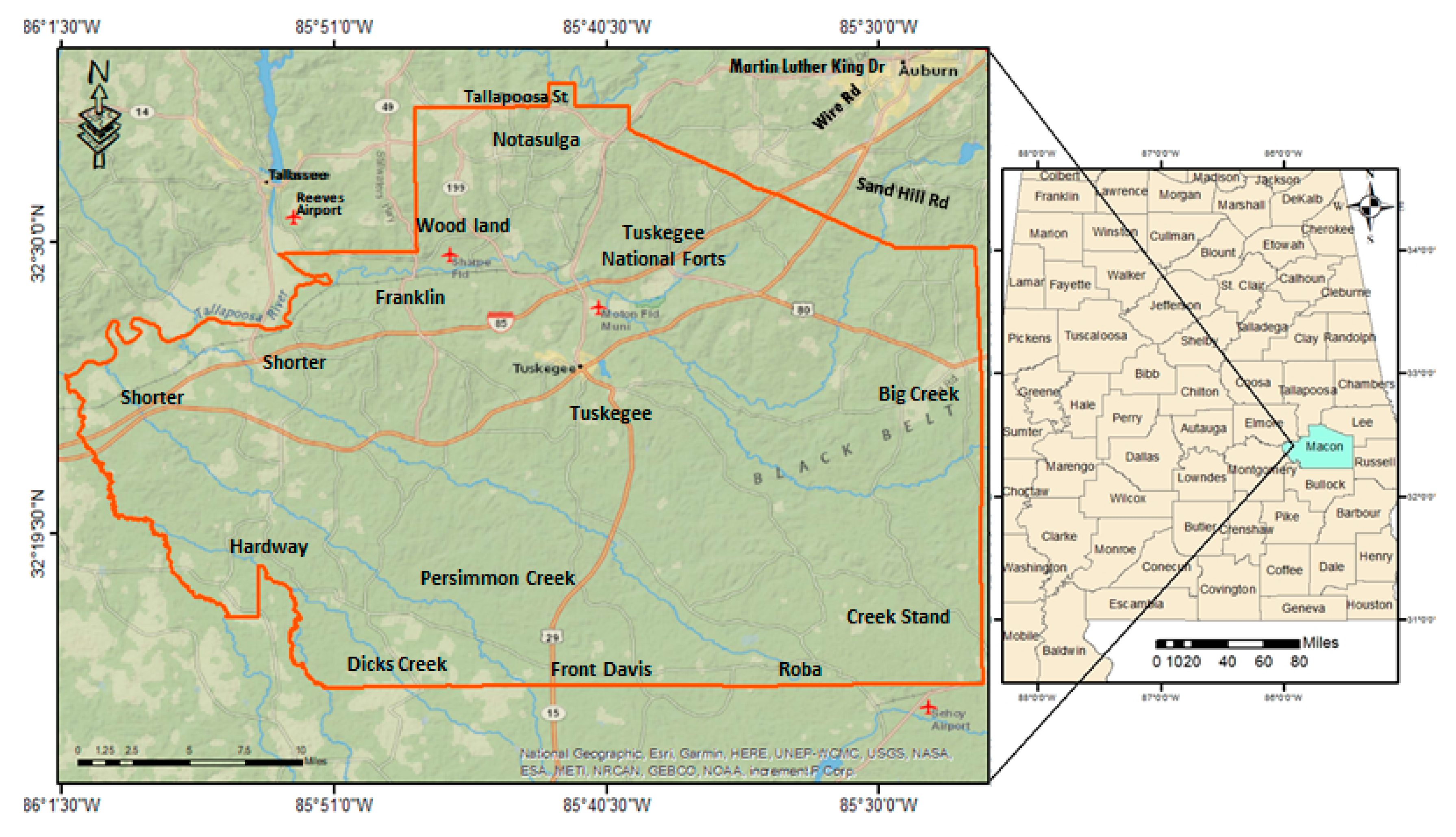
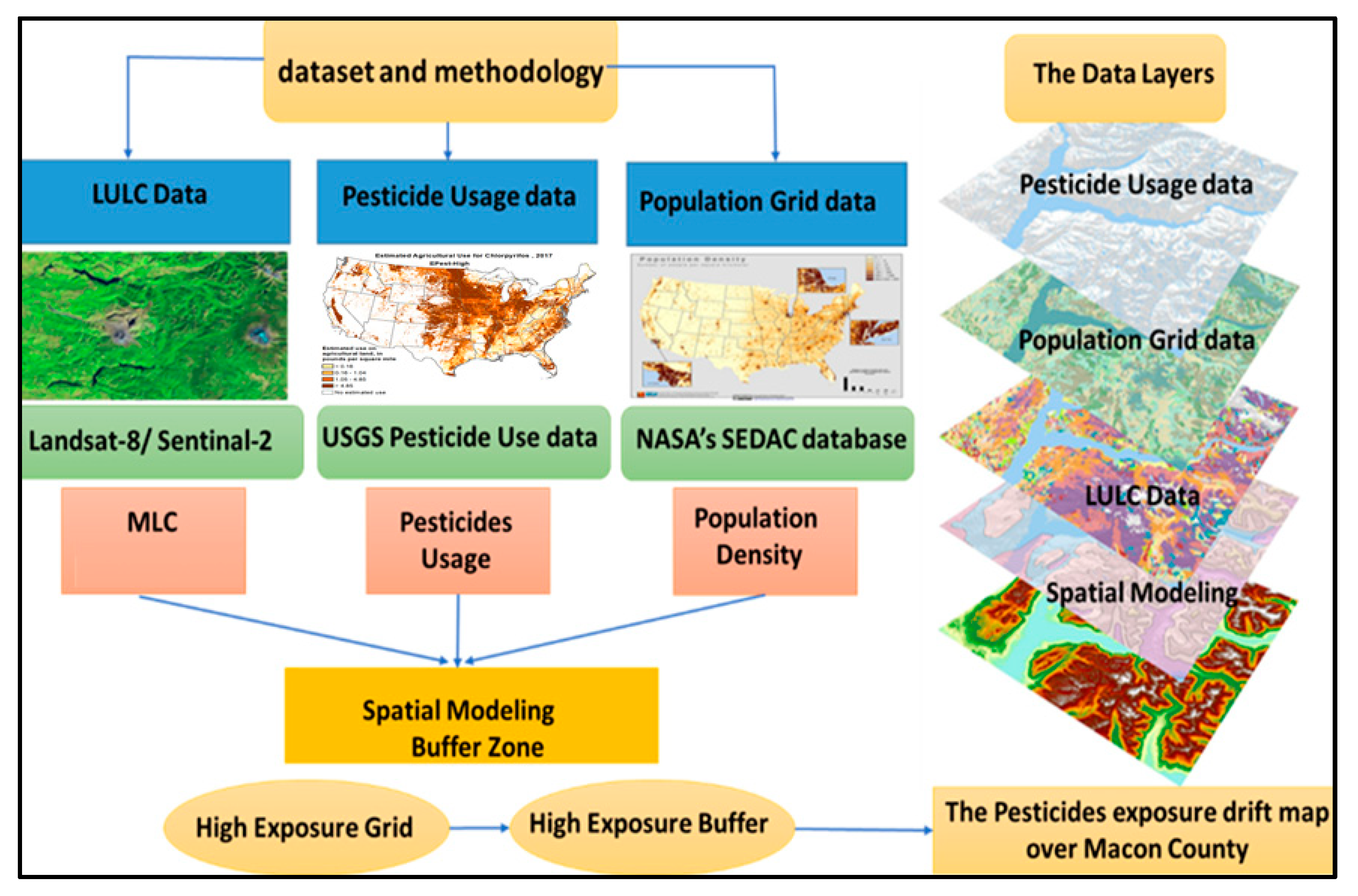

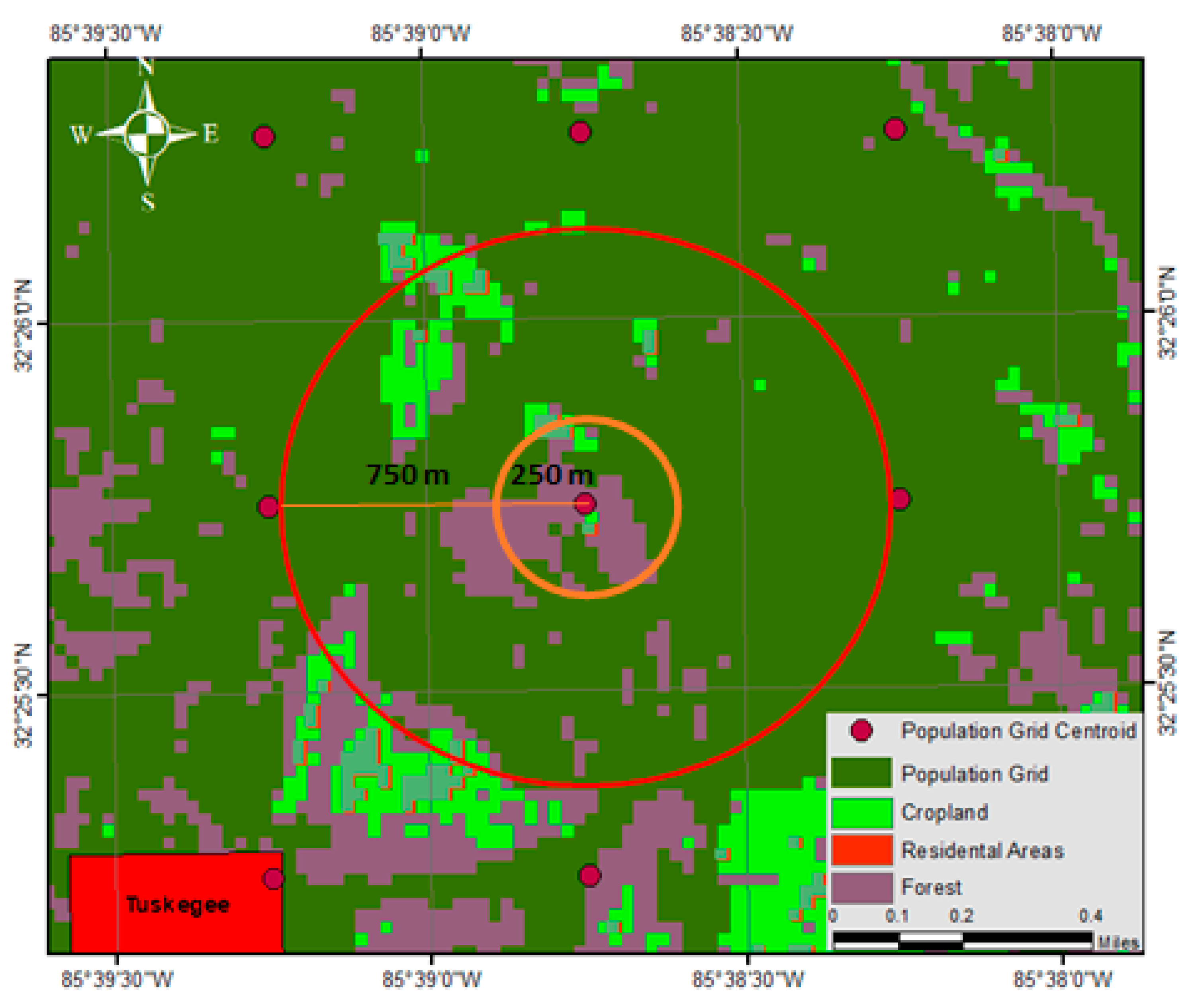
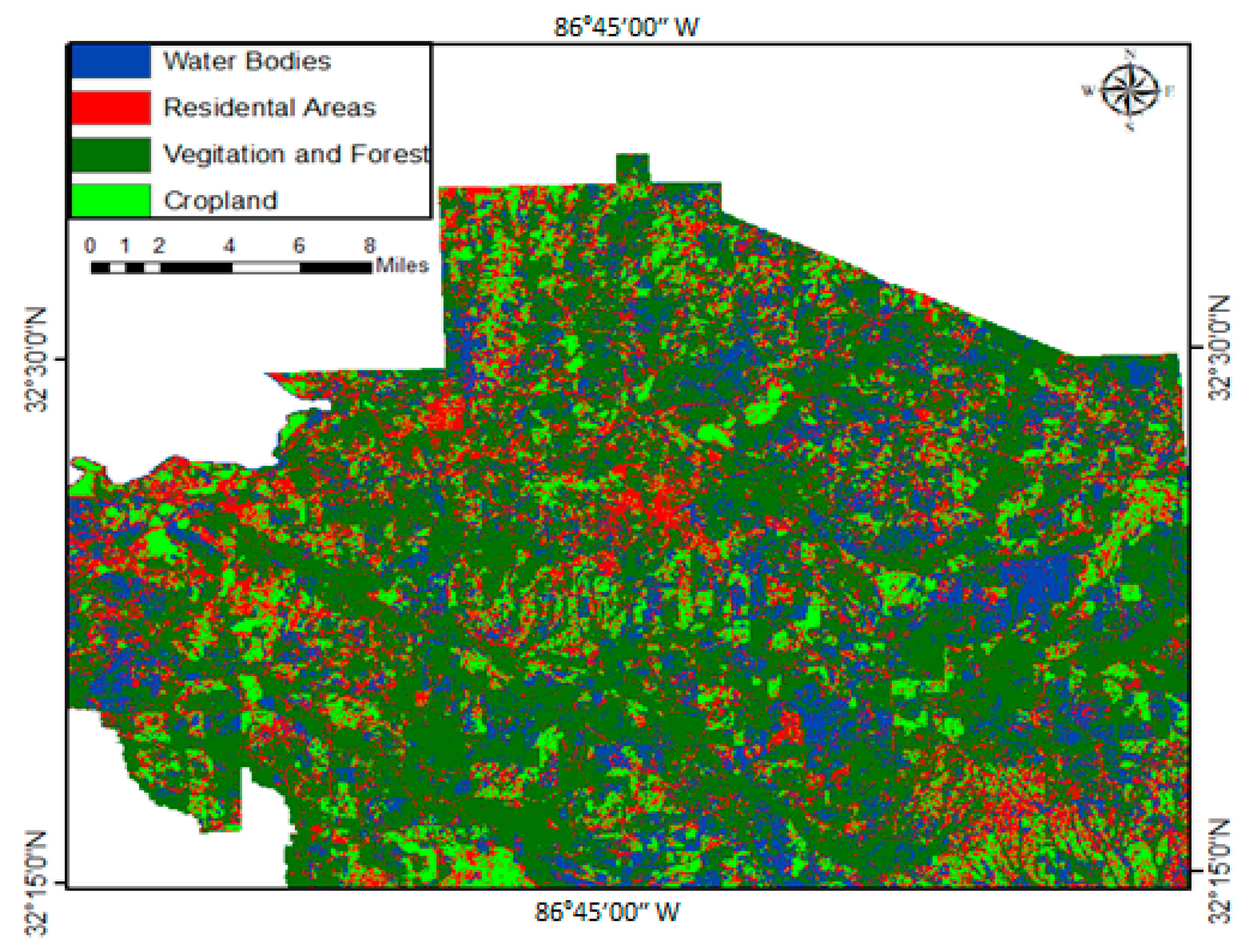



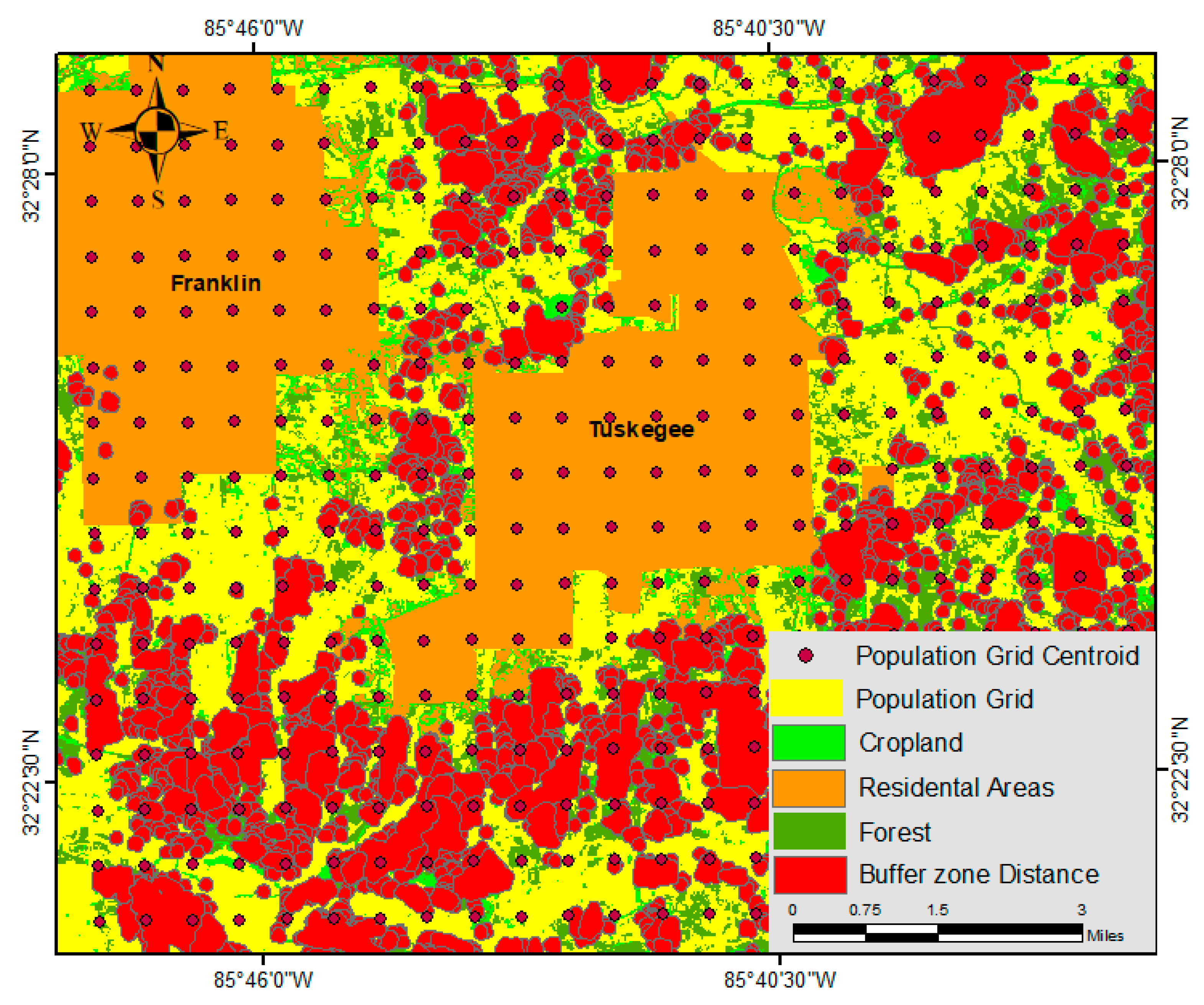
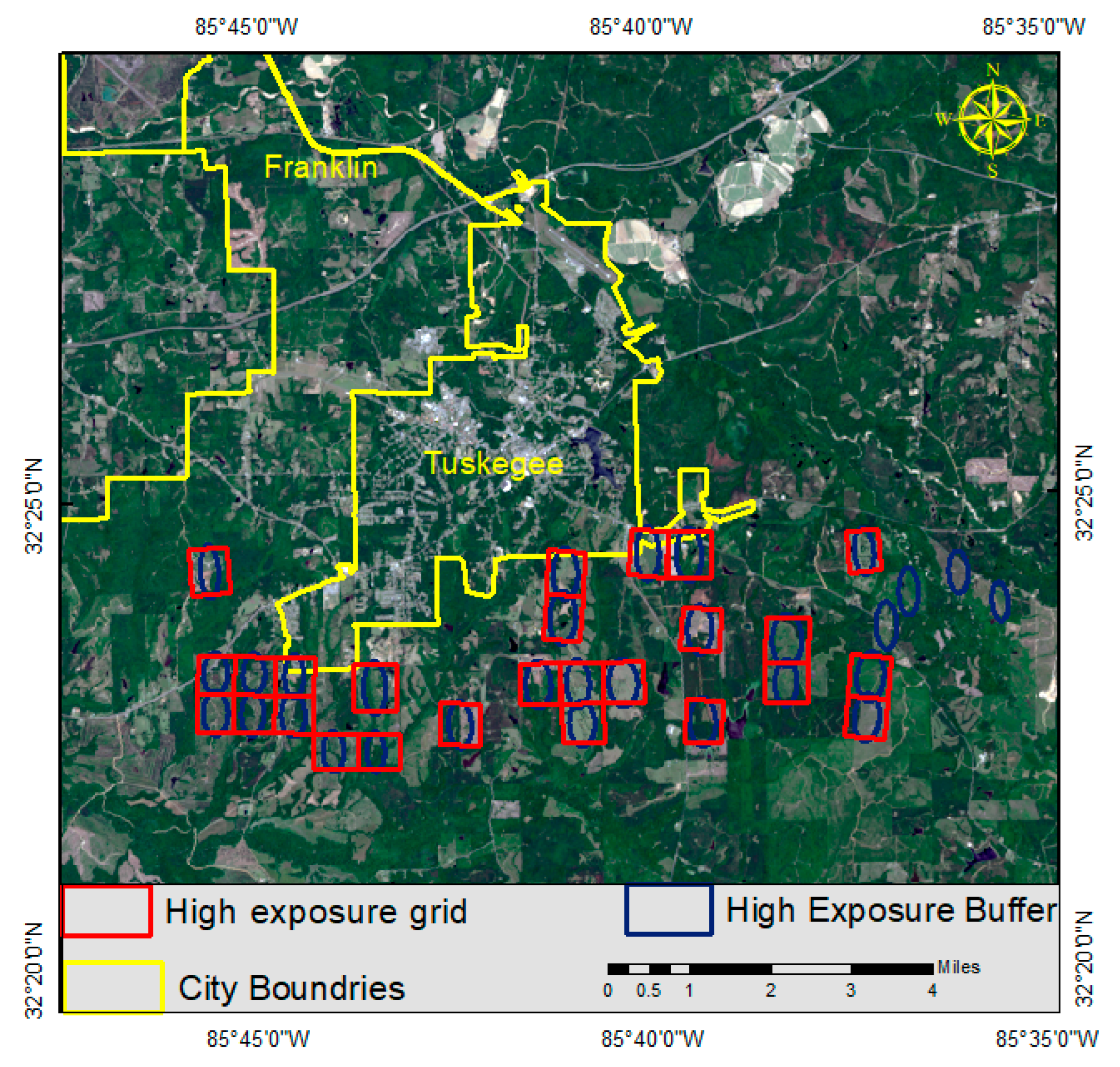
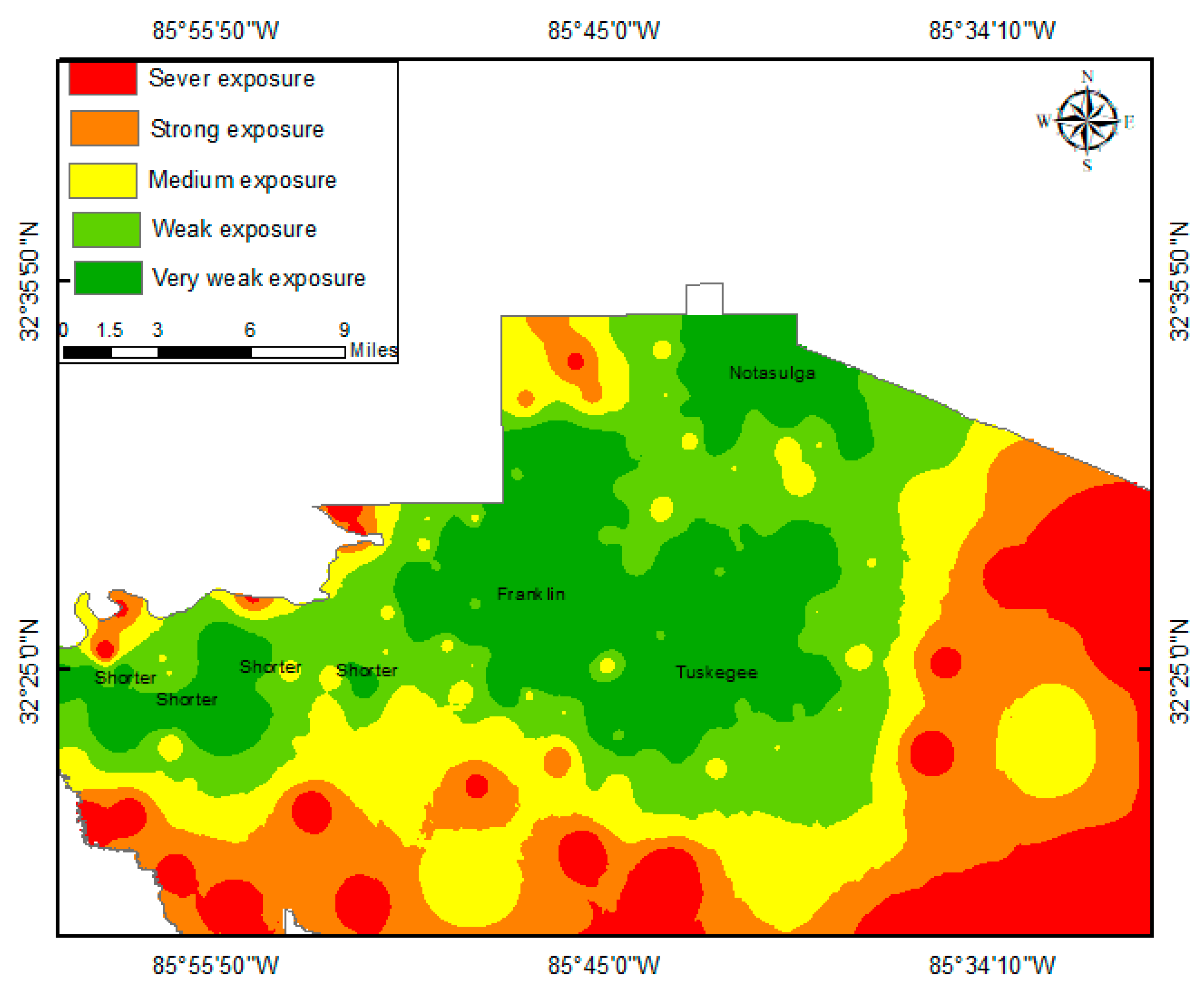
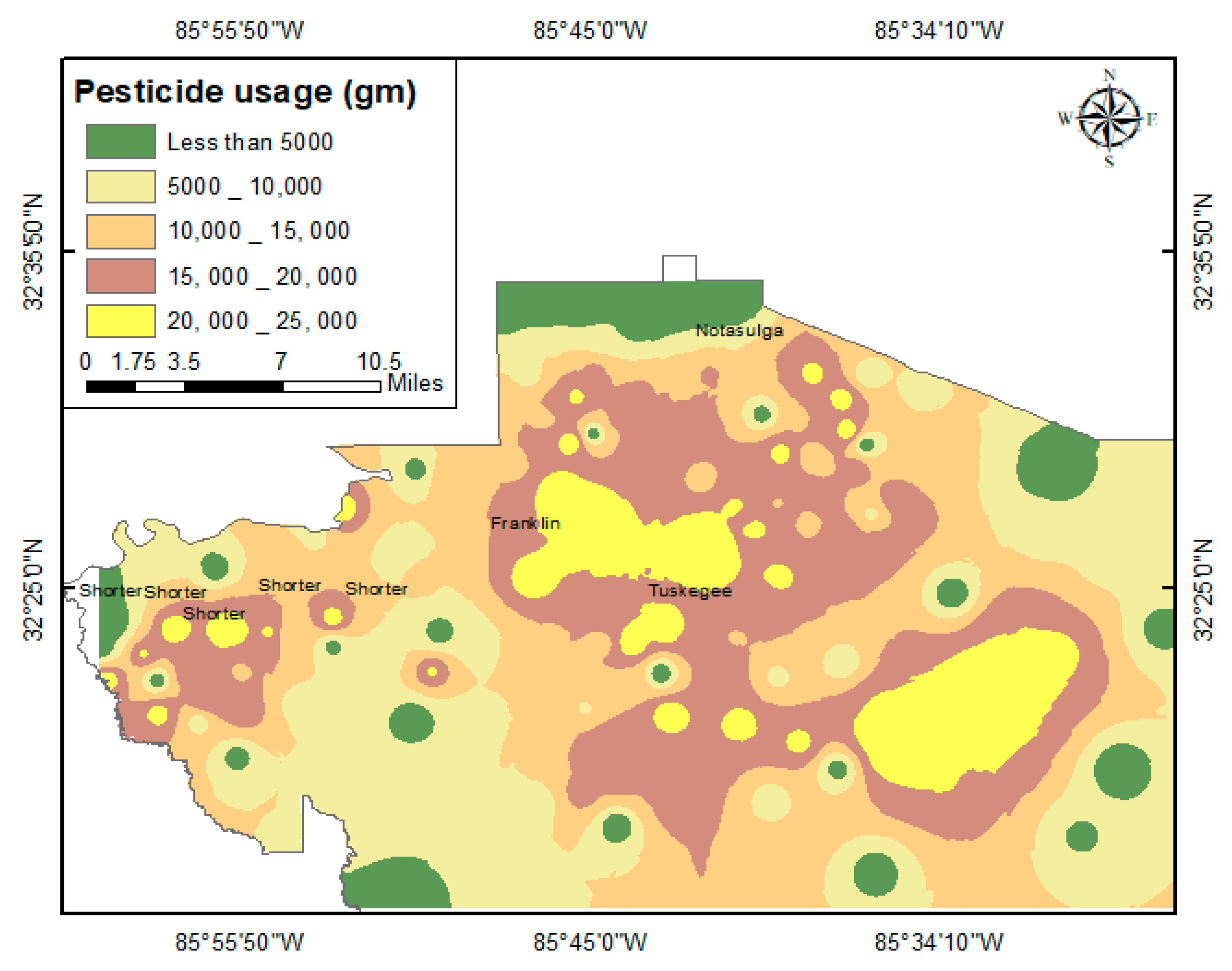
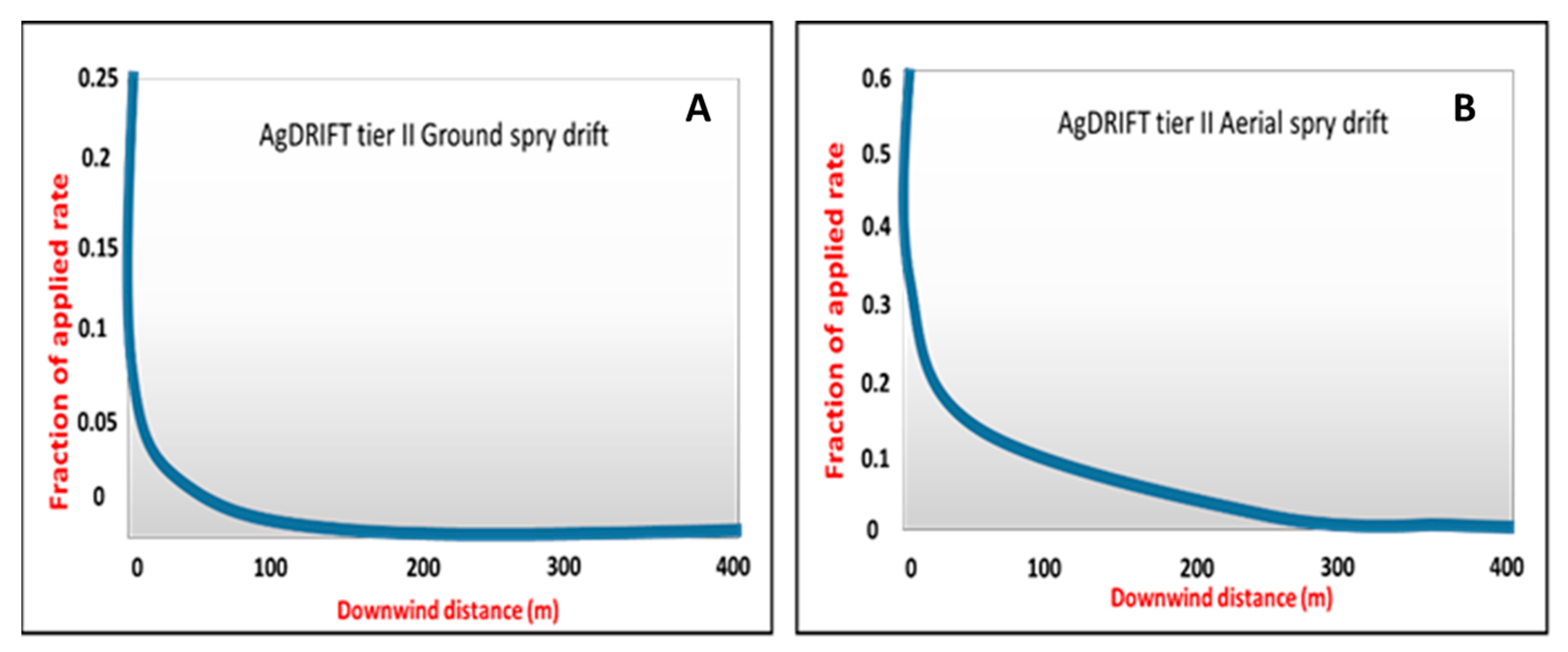
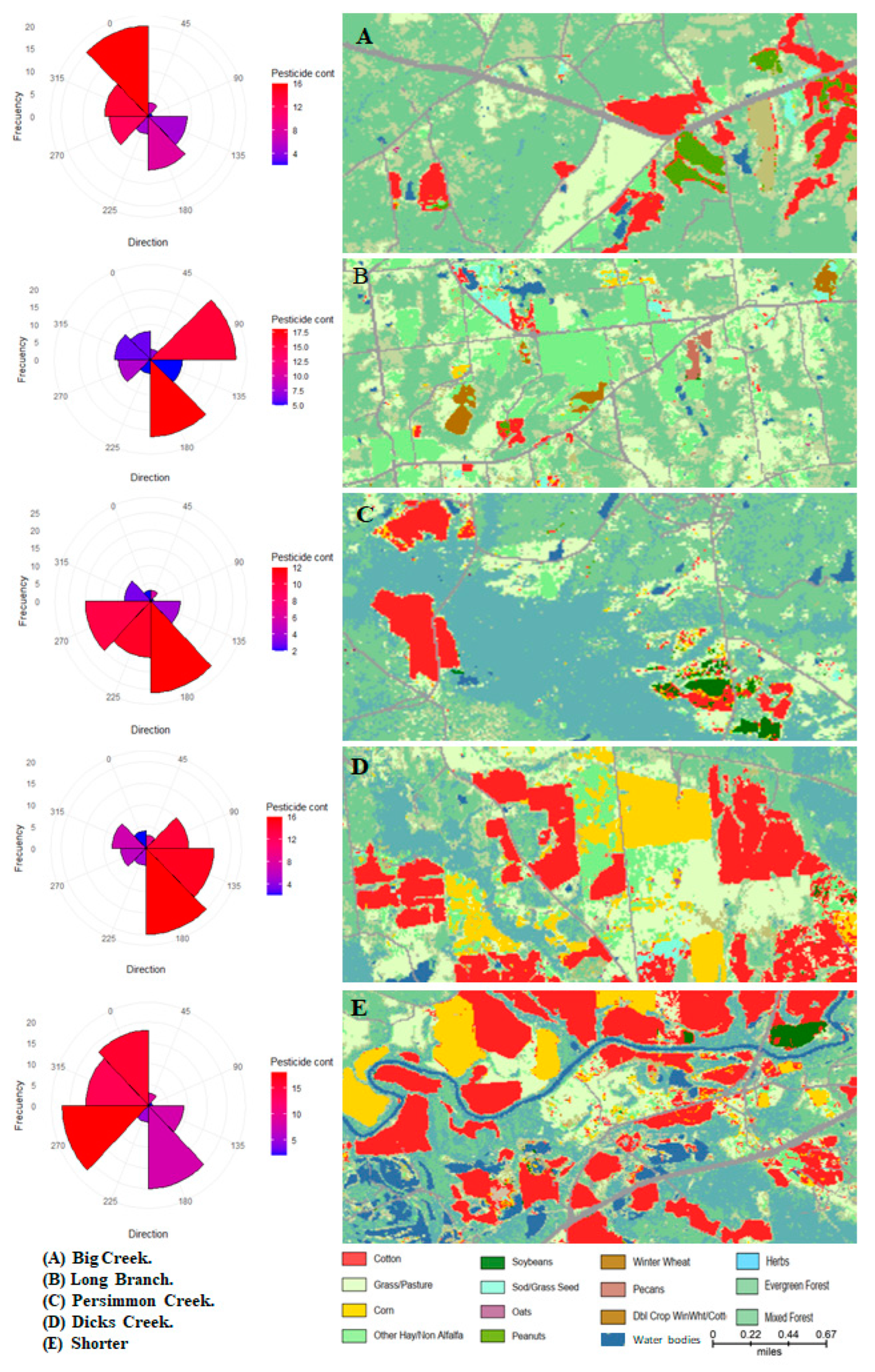
| Image Number | Date of Acquisition | Time of Acquisition (AM) | Cloudiness % | |
|---|---|---|---|---|
| Row | Path | |||
| 038 | 019 | 6 August 2017 | 10:23 | 6.04 |
| 037 | 020 | 6 August 2017 | 10:24 | 5.74 |
| Items | Definition | Alabama | Macon | % |
|---|---|---|---|---|
| ATLAS_ACRE | Area of the administrative region in acres | 3,241,319 | 389,636 | 1.20 |
| ACRES_HC | Acres of harvested cropland in acres | 2,205,766 | 26,305 | 1.19 |
| SQ_MI_HC | Square miles of harvested cropland | 50,647 | 41.00 | 0.1 |
| AGG_HI_KG | The sum of the EPest-high estimates for all seven organophosphates in kilograms (kg) | 235,141 | 3721 | 1.6 |
| AGG_HI_LB | The sum of the EPest-high estimates for all seven organophosphates in pounds (lbs) | 518,396 | 8204 | 1.5 |
| HI_LOG_RAT | The log of the concentration of organophosphate use across- harvested cropland for EPest-high estimates, in pounds per square mile | 1455.00 | 2.30 | 0.16 |
| HILBSQMIHC | The concentration of organophosphate unused cross-harvested cropland, for EPest-high estimates, in pounds per square mile | 12,100 | 200.00 | 1.7 |
| Pesticide Name | Usage kg/ha |
|---|---|
| Acephate | 24.70 |
| Chlorpyrifos | 50.60 |
| Dicrotophos | 94.30 |
| Phorate | 410.50 |
| Phosmet | 170.30 |
| Terbufos | 150.00 |
| Tribufos | 2843.30 |
| Total | 3743.70 |
| Field Name | Spray Date | Location Lon/Lat | Pixel Count | Area (ha) | Applied Rate (kg/ha) | Wind Direction | Method | Drift Mass (kg) | Drift/ Total Applied (%) |
|---|---|---|---|---|---|---|---|---|---|
| Big Creek | 1 August 2017 | −85°45′00″ 32°42′06″ | 41,656 | 92,643 | 2.24 | SSW | Aerial | 1.20 | 6.02 |
| Dicks Creek | 7 August 2017 | −85°59′40″ 32°24′50″ | 60,255 | 134,004 | 2.24 | NNW | Ground | 0.90 | 2.99 |
| Persimmon Creek | 15 August 2017 | −85°54′53″ 32°32′42″ | 41,745 | 92,838 | 2.24 | SSE | Aerial | 1.20 | 5.75 |
| Long Branch | 22 August 2017 | −85°48′52″ 32°24′48″ | 41,540 | 92,381 | 2.24 | SE | Ground | 0.90 | 4.35 |
| Shorter | 29 August 2017 | −85°33′00″ 32°39′09″ | 75,075 | 166,963 | 2.24 | WNW | Aerial | 1.20 | 3.21 |
Disclaimer/Publisher’s Note: The statements, opinions and data contained in all publications are solely those of the individual author(s) and contributor(s) and not of MDPI and/or the editor(s). MDPI and/or the editor(s) disclaim responsibility for any injury to people or property resulting from any ideas, methods, instructions or products referred to in the content. |
© 2023 by the authors. Licensee MDPI, Basel, Switzerland. This article is an open access article distributed under the terms and conditions of the Creative Commons Attribution (CC BY) license (https://creativecommons.org/licenses/by/4.0/).
Share and Cite
El Afandi, G.; Ismael, H.; Fall, S.; Ankumah, R. Effectiveness of Utilizing Remote Sensing and GIS Techniques to Estimate the Exposure to Organophosphate Pesticides Drift over Macon, Alabama. Agronomy 2023, 13, 1759. https://doi.org/10.3390/agronomy13071759
El Afandi G, Ismael H, Fall S, Ankumah R. Effectiveness of Utilizing Remote Sensing and GIS Techniques to Estimate the Exposure to Organophosphate Pesticides Drift over Macon, Alabama. Agronomy. 2023; 13(7):1759. https://doi.org/10.3390/agronomy13071759
Chicago/Turabian StyleEl Afandi, Gamal, Hossam Ismael, Souleymane Fall, and Ramble Ankumah. 2023. "Effectiveness of Utilizing Remote Sensing and GIS Techniques to Estimate the Exposure to Organophosphate Pesticides Drift over Macon, Alabama" Agronomy 13, no. 7: 1759. https://doi.org/10.3390/agronomy13071759
APA StyleEl Afandi, G., Ismael, H., Fall, S., & Ankumah, R. (2023). Effectiveness of Utilizing Remote Sensing and GIS Techniques to Estimate the Exposure to Organophosphate Pesticides Drift over Macon, Alabama. Agronomy, 13(7), 1759. https://doi.org/10.3390/agronomy13071759








